Bikaner city in Rajasthan is well known for its Jain temples, a few of which are Adinatha Temple, Neminatha Temple, and Bhandasar Temple. [1] Among these, the Seth Bhandasar Jain Temple, constructed in the early 16th century CE during the rule of Rao Lunkaran, is one of the most ornate and exquisite temples. The mandapa (pillared hall) of this temple supports a dome resting on an eight-sided pillar and beam arrangement. All the pillars, beams, wall surfaces and the domical ceiling are beautified with paintings. Noteworthy among these are the paintings on the semi-circle of the dome. Defined in oval shapes with stories from the lives of Jain monks and Tirthankaras (spiritual teacher), most of these paintings have inscriptions explaining the story that the painting depicts. The ovals are designed like mirrors with carved wooden frames, which create an overall effect that the ceiling has several of these mirrors hanging on its surface. Hermann Goetz remarks that the tradition of painting stories on the ceilings in oval cartouches is one of the prominent highlights of the Bikaneri Rajput school of painting style. [2]
The area surrounding the ovals is adorned with a network of floral designs markedly beautified with golden paint. Upon seeing this ornamented pattern of floral art, one is reminded of the inlay work done in semi-precious stones commonly found in Mughal buildings such as mausoleums and tombs. The lower edge of the semi-circular dome is separated from the circular bands depicting the scenes from the Bikaner town by a row of semi-circular floral motifs in a bright red colour. Likewise, the centre of the dome is accentuated by a lotus medallion with a suspending finial. Since the Bikaneri Rajput style of art and painting was influenced by Mughal art, the choice of colours and ornamentation patterns are vibrant. The themes that the paintings include range from a wide variety of floral and faunal motifs to the inclusion of mythical and religious stories.
Though the core structure of the temple is old, the paintings have been retouched from time to time. The latest restorations to the paintings happened about a decade ago, as indicated by date inscribed on the paintings. Though the paintings are not contemporary to the construction of the temple, the themes and historical stories are central to Jain traditions. There are two concentric circles containing these paintings, and each circle contains sixteen ovals with different stories. The lower or the bottom circle has stories of the deeds of two significant Jain ascetics, regarded as acharyas (those who impart knowledge), Jinadatta Suri and Jinachandra Suri, who were active in the 12th and 16th- 17th centuries CE, respectively. Both belong to the Khartar Gaccha, one of the largest Jain monastic orders of the murtipujaka (idol worshippers) from the Shvetambara belief system, formed in the 11th century CE by Vardhaman Suri. Jinadatta Suri (1075 -1154 CE) and Jinachandra Suri II (1538-1613 CE) are two of the four Dada Gurus (spiritual guides) of the belief system.[3] There are several miracles attributed to both these Dada figures.
Jinadatta Suri was born in Gujarat in the late 10th century CE to Vachag and Bahar Devi of the Humbad clan. [4] Born as Somchandra, he renounced his luxurious life to become a monk at the tender age of eleven and was initiated into the Khartar Gaccha. Eventually, he assumed the role of an acharya in the monastic order. He was the first one to receive the title ‘Yugpradhan’, which, as per legend, was bestowed upon him by Goddess Ambika. Among the paintings depicted on the semi-circular dome in the Bhandasar Temple, most paintings depict scenes from the life and work of Jinadatta Suri. There are several miracles associated with Jinadatta Suri that reiterate his control over supernatural beings and divine powers. [5]
Jinachandra Suri, the Dada Guru, was born in the 16th century CE in Khetasar near Jodhpur to Seth Shrivant Shah and Shridevi, who named him Sultan Kumar. [6] He was also initiated into the Jain monastic traditions at a tender age and later went on to work relentlessly for the Khartar Gaccha. He resided in Bikaner for some time and toured pilgrimage places all over India, propagating Jain principles. Jinachandra Suri, also known as Jinachandra Suri II, was one of the few Jain preachers to be invited to the royal court of the Mughals during the reign of Akbar. [7] The strong effort of the Mughal Emperor to establish political ties with the Rajputs was achieved through the inclusion of Rajputs in the Mughal military and matrimonial alliances between the two factions. This led to the migration of several Rajput Jain followers outside of Rajasthan. Jinachandra Suri was invited to the Mughal court in consultation with Karamchandra (or Karamchand) Bacchawat, the diwan of Bikaner from the Bacchawat family and a trusted official in the Mughal court. [8] Being impressed by his deeds, Jinachandra Suri was bestowed with the title of ‘Yugpradhan’ by Akbar in consultation with Karamchand. The Mughal Emperor had a renewed interest in the Jain faith because of the teachings of Shri Jinachandra Suri. The Acharya also got several farmans (orders) passed for the protection of Jain laity and religious places and to reduce animal slaughter. In Bhandasar, only two paintings depicting scenes from his life have been shown, the most significant of which is a meeting between Emperor Akbar and Dada Jinachandra Suri. Both these figures are shown wearing white loincloths, in accordance with the Shvetambara belief system practices.
The inner circle of the paintings on the dome has stories from the life of Jain Tirthankaras – Parshvanatha, Mahavira, Neminatha and Rishabhnatha along with some vital preachings and auspicious symbols that are sacred to Jain traditions. These include the depictions of Meru Parvata and Chaude Rajlok, which are some of the important preachings. Among the depictions of the Tirthankaras, Mahavira and Parshvanatha Swami’s stories have the upper hand. The paint from the paintings in this circle flaked in a few places, occasionally, also making the inscriptions illegible. Hence, only a few paintings from this circle have been included in this essay.
The paintings, in their display of Rajput architecture, like havelis (mansions), temples, and fortification walls, showcase the influence of the contemporary period in which they were made. This is reflected in the Rajput buildings, which resemble European castles and pillars. Dada Guru, Jain Acharya, and his disciples are shown wearing white loin cloths and wrapped pieces in all the paintings. The Acharya is shown with a divine halo in all the paintings. All these paintings were retouched in 2000 by Usta artist of Bikaner, Mr M. Altaf. He is a trained artist in Usta Kala, the famous painting style peculiar to Bikaner, which came to him as a hereditary practice. Thus, the stories of the paintings are historical, but the details of the paintings have incorporated the contemporary period details.

The interiors of the Seth Bhandasar Jain Temple are highly ornate. All wall surfaces, pillars and ceilings have beautiful paintings, and the mandapa (pillared hall) of the temple is noteworthy. The paintings are from various themes, including depictions of twenty Tirthankaras, the lives and works of Jain monks, vital pilgrimage sites, and teachings of the Jain traditions, among others.
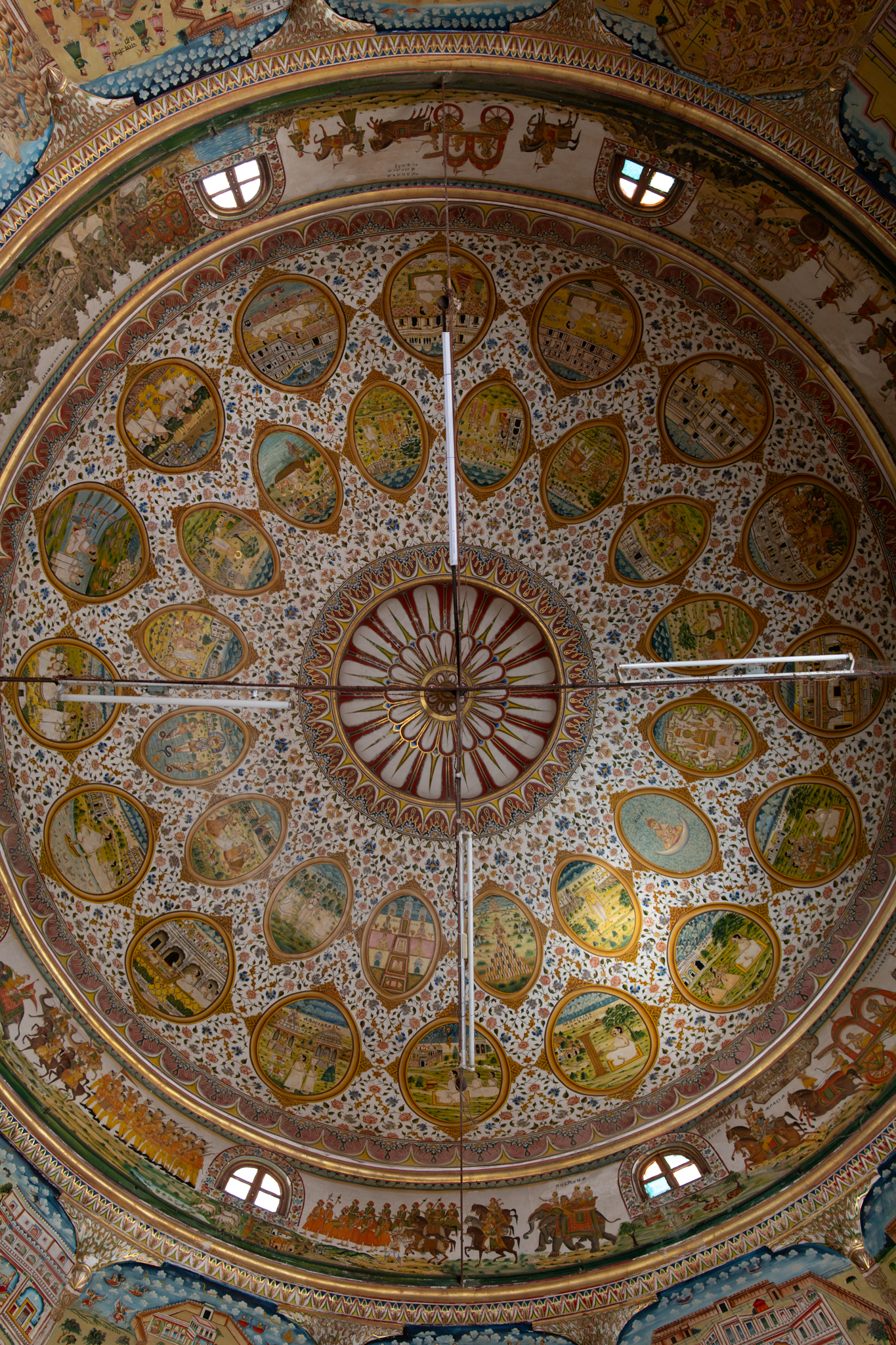
The dome above the mandapa (pillared hall) of the Bhandasar Temple features two circles consisting of sixteen oval-shaped designs resembling mirrors. The outer or lower row depicts miraculous deeds from the lives of Jain Acharyas, Dada Guru Jinadatta Suri and Dada Guru Jinachandra Suri. The inner or upper row has stories from the lives of Rishabhnatha, Mahavira, Parshvanatha and Neminatha Tirthankaras. This row also includes auspicious symbols and preachings of the Jain traditions. The oval paintings are placed on a background of floral ornamentation. All the paintings have inscriptions detailing the stories they represent.
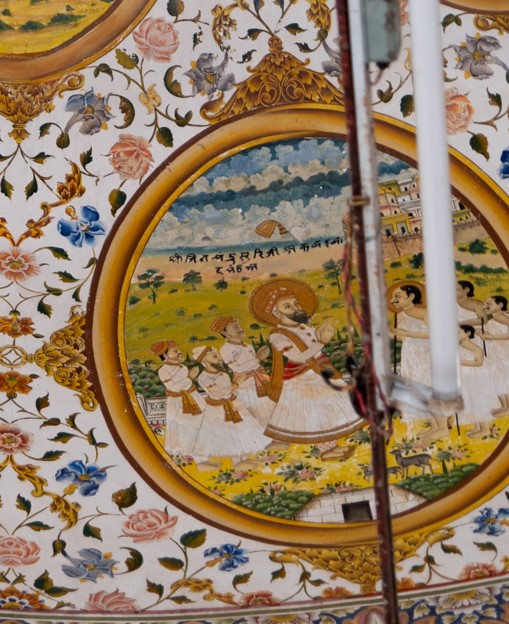
The first oval painting (in clockwise order) in the lower/outer circle in the ceiling of the mandapa (pillared hall) is the depiction of the meeting between Jain Acharya (those who impart knowledge), Shri Jinachadra Suri and the Mughal Emperor Akbar. He was invited to the Mughal court through Akbar’s court official Karamchand Bacchawat, who was from Bikaner. The painting has havelis (mansions) in the background, and the two leaders greet each other at the forefront. It is also said that Karamchand went to receive Jinachandra Suri on the outskirts of the city. The inscription reads, ‘Shri Jinadatta Suriji Akbar Badshah.’
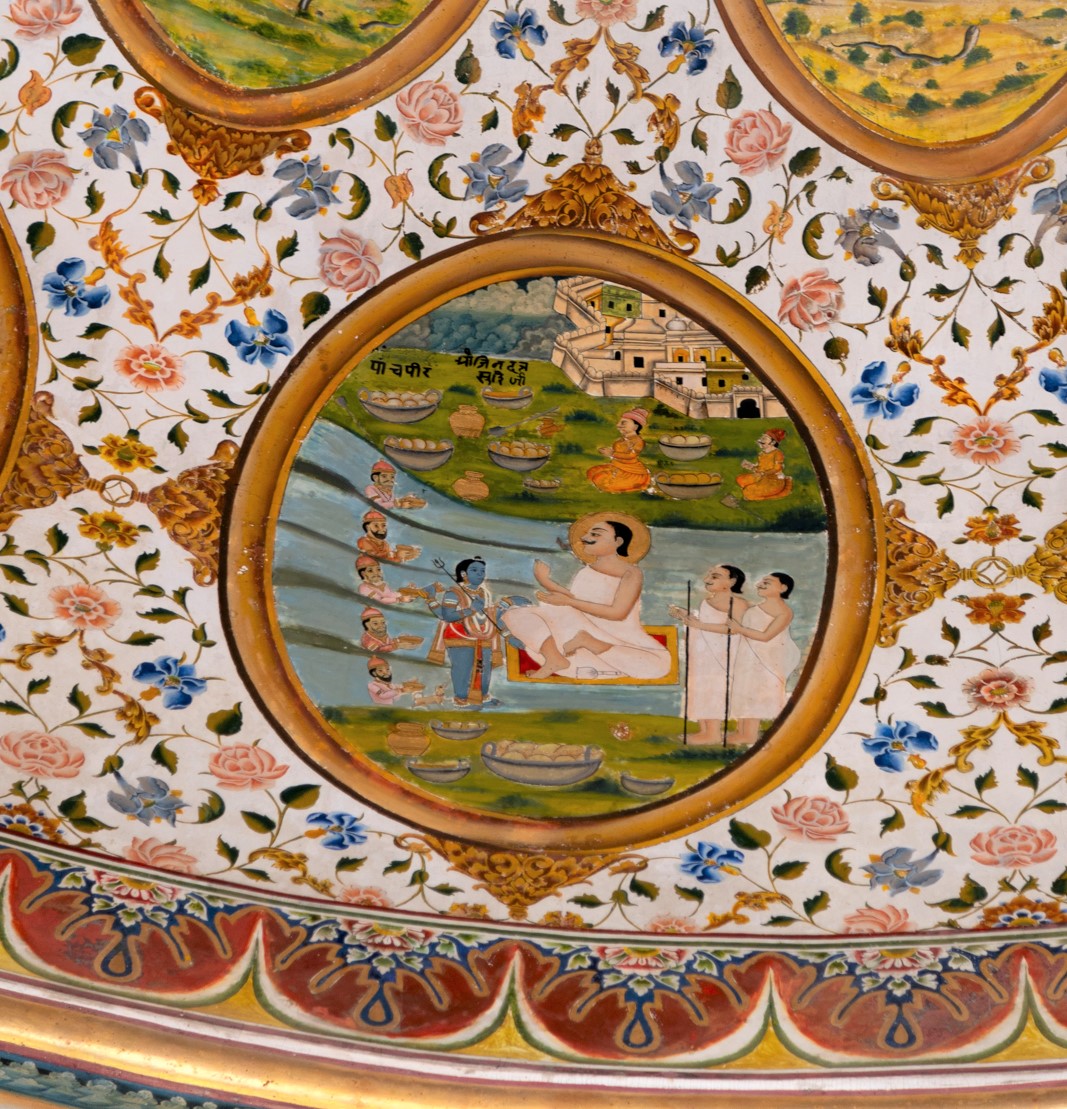
The second oval painting (in clockwise order) in the lower/outer circle in the ceiling of the mandapa (pillared hall) is the episode of Panch Pir coming to greet Jinadatta Suri. The story is closely associated with Jinachandra Suri, who subdued five pirs (spiritual guides) who stood at the confluence of five rivers upon the request of Emperor Akbar. The painting depicts five human figures in five streams of water, approaching to pay their respects to the acharya (those who impart knowledge). On the banks, devotees are shown sitting with offerings. The inscription reads, ‘panch pir shri Jina datta suri ji.’

The third oval painting (in clockwise order) in the lower/outer circle in the ceiling of the mandapa (pillared hall) depicts an episode from Jinachandra Suri's life. Once, a disciple of Jinachandra Suri mistakenly told a Muslim religious leader it was a no-moon day when it was a new moon day. The Muslim leader spread the misinformation across the city, questioning the disciple’s knowledge of the day. To rectify the situation, Jinachandra Suri threw a gold plate into the sky, covering the moon and thus converting the day into a no-moon day. This miracle is supposed to have taken place in front of Emperor Akbar. The inscription reads, ‘Shri Jinachandra Suri ji na Purnima kari.’

The fourth oval painting (in clockwise order) in the lower/outer circle in the ceiling of the mandapa (pillared hall) is an episode about Jinachandra Suri’s life. The inscription on the viewer’s left side of the painting is lost, hence the exact episode is unknown. The painting depicts a Mughal official with his attendants bowing down to Jinachandra Suri, accompanied by his disciples, during a religious gathering. The acharya (those who impart knowledge) is seen pointing towards the sky, where lightning strikes. The episode is happening in front of a haveli. In the foreground of the painting, two Mughal officials, possibly sitting on horses, are depicted. A similar episode is found in the life of Jinadatta Suri, where he saves his followers from drowning in another part of the world, showcasing his knowledge and power. The remnant inscription reads, ‘Shri Jinachandra Suri ji.’

The fifth oval painting (in clockwise order) in the lower/outer circle in the ceiling of the mandapa (pillared hall) is the episode where Jinadatta Suri saved the life of an unwell child brought to him by two women. The episode takes place outside a haveli, probably near the place where the acharya (those who impart knowledge) is meditating. The acharya is shown blessing the child by placing his palm on the child’s head. The inscription reads, ‘Shri Jinadatta Suriji balak jivayo.’

The sixth oval painting (in clockwise order) is in the lower/outer circle in the ceiling of the mandapa (pillared hall) of the Bhandasar Temple. Here is another episode depicting the acharya’s (those who impart knowledge) miraculous powers in saving lives. Two disciples are shown seeking help from the acharya, who is then depicted granting them the necessary assistance. The inscription reads, ‘Shri Jinadatta Suriji anas ro ji vayo.’

Jinadatta Suri is depicted here with his disciple, who is curing a person of his ailment. The acharya (those who impart knowledge) is renowned for such miraculous deeds. This seventh oval painting (in clockwise order) in the lower/outer circle in the ceiling of the mandapa (pillared hall) is the last of four paintings dedicated to the miracles of Jinadatta Suri, through which the acharya saved several lives. The inscription reads, ‘Shri Jinadatta Suriji sapata spa dene ji vayo.’
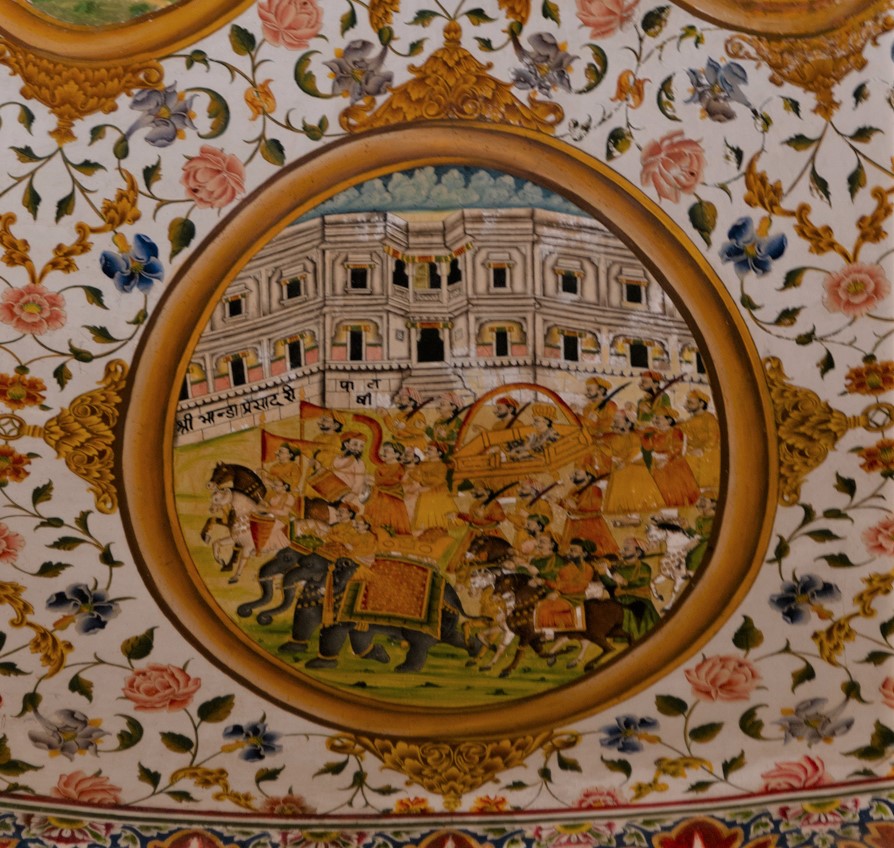
The episode in the eighth oval painting (in clockwise order), in the lower/outer circle in the ceiling of the mandapa (pillared hall), oval painting deviates from the usual stories of the Dada Guru, but holds importance in the context of the temple. The painting depicts a procession, the palkhi (palanquin) of Bhandaprasad, the Sethia credited with the patronization of the Bhandasar Temple. The procession shown in the painting is grand, with Bhandaprasad being carried in a palkhi by four men and accompanied by foot soldiers, cavalry, elephants and horse riders. The procession is passing by a Rajasthani haveli (mansion). The inscription reads, ‘Shri Bhandaprasad ri Palkhi.’

The ninth oval painting (in clockwise order) in the lower/outer circle in the ceiling of the mandapa (pillared hall) is difficult to decipher. It appears to depict a sleeping couple with a snake near the leg of the man. Outside the haveli (mansion), which houses this couple, there is an armed figure that looks like a soldier or guard in uniform.
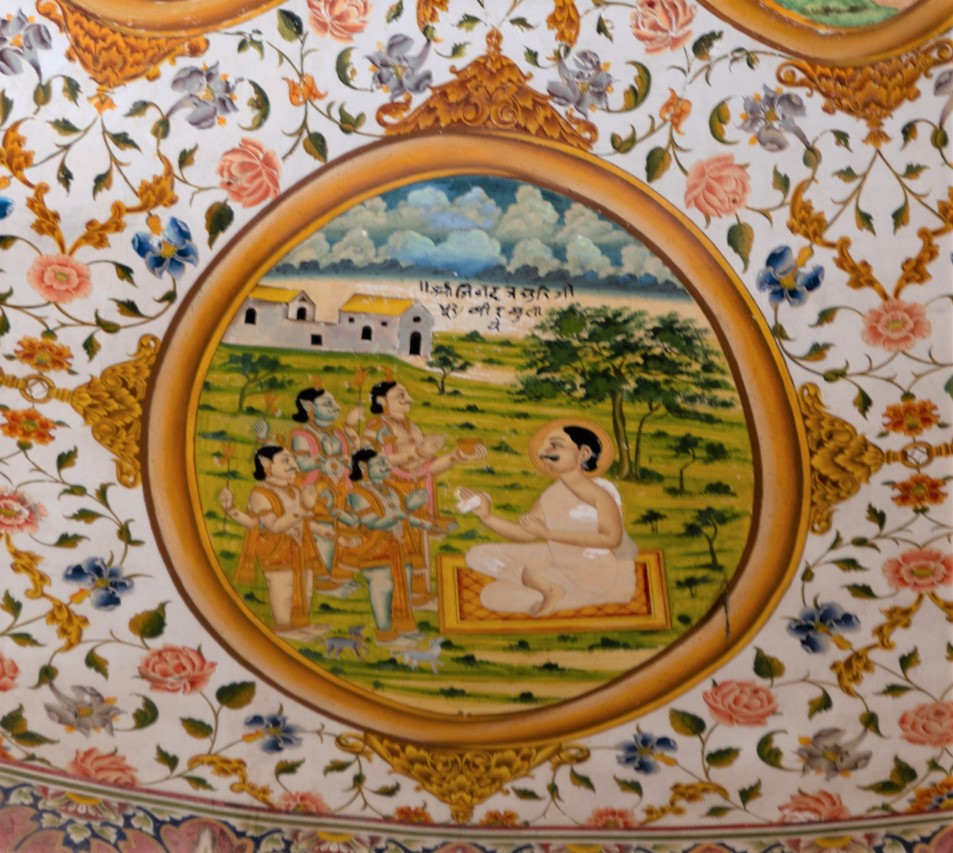
The tenth oval painting (in clockwise order) in the lower/outer circle in the ceiling of the mandapa (pillared hall) is an episode from the life of Jinadatta Suri. It is said that he subdued the bavan (fifty-two) Bhairava pirs (spiritual guides), who eventually became his servants. Jinadatta Suri is shown sitting in a van (forested area), and the four pirs representing the fifty-two Bhairava pirs are dressed like Hindu deities. As suggested by Lawrence Babb, this is indicative of the tussle between two religious factions, the Jains and the Shaivas. The inscription reads, ‘Shri Jinadatta Suri Ji 52 bir bulaye.’

One of the most well-known stories of the miracles of Jinadatta Suri, the eleventh oval painting (in clockwise order) in the lower/outer circle in the ceiling of the mandapa (pillared hall) depicts this episode of the story of sixty-four yoginis. The story takes place in Ujjain. Once, Jinadatta Suri was amidst a religious discourse when he foresaw that sixty-four yoginis were coming his way to disturb the gathering. The yoginis arrived disguised as laywomen. Jinadatta Suri asked his disciples to spread sixty-four mats for the yoginis, and using his powers, the acharya (those who impart knowledge) glued the yoginis to the mat. This way, the yoginis were compelled to attend the religious discourse and eventually became disciples of Jinadatta Suri. According to Lawrence Babb, this episode depicts the Jain attempt to tame the tantric goddesses. The inscription reads, ‘Shri Jinadatta Suriji 64 joganiya saji.’

The twelfth oval painting (in clockwise order) in the lower/outer circle in the ceiling of the mandapa (pillared hall) is the episode of Jinadatta Suri when he procured texts which were hidden in the pillar by a Jain ascetic several years ago. No one knew the location of the sacred scriptures, but the acharya (those who impart knowledge) could discern it using his magical powers. The pillar containing the sacred scriptures is depicted as a fluted column. This painting bears the name of the painter, M. Altaf Usta. The word ‘Usta’ used as a suffix here comes from the word ustad, meaning expert.
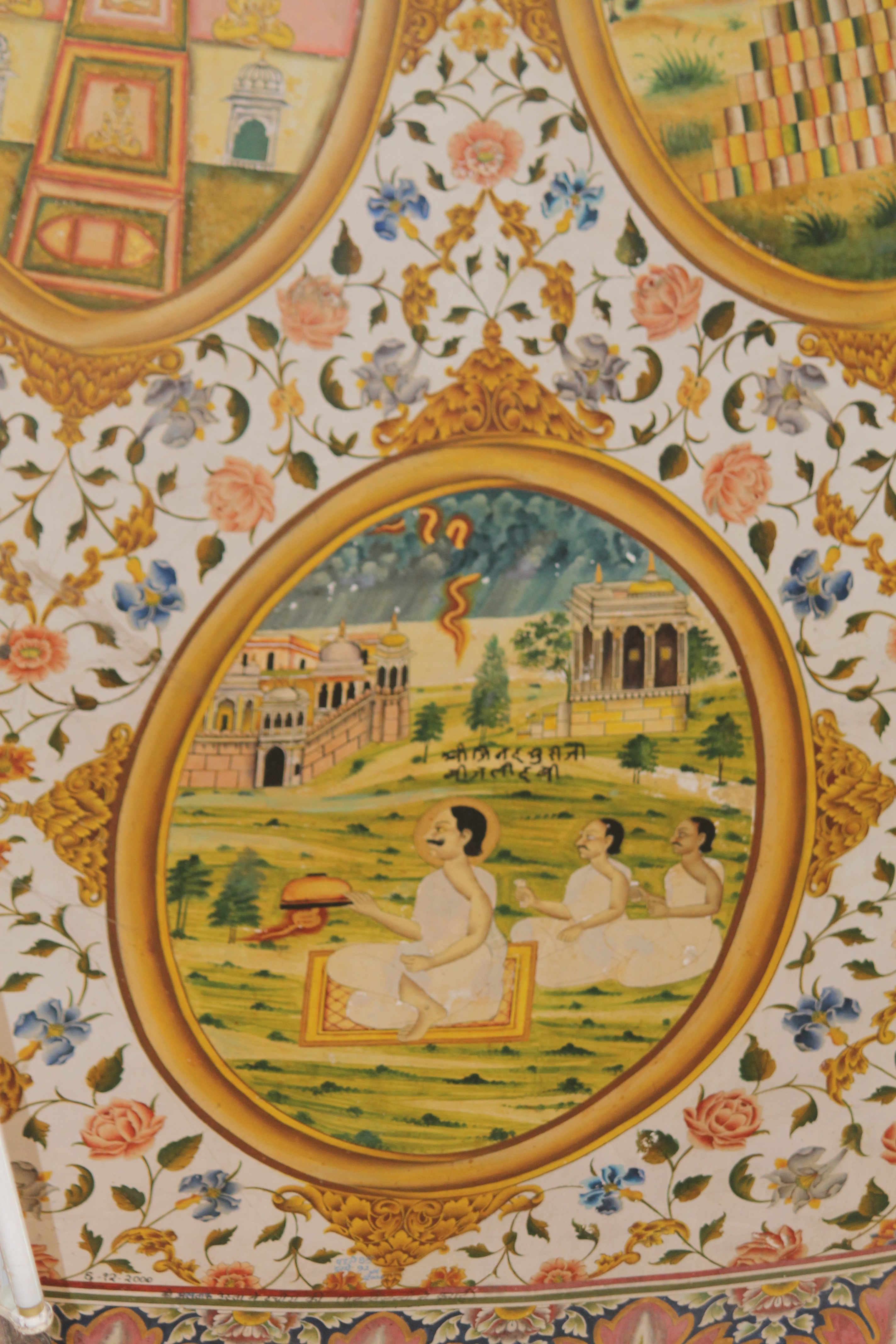
The thirteenth oval painting (in clockwise order) in the lower/outer circle in the ceiling of the mandapa (pillared hall) is the episode from Jinadatta Suri's life that took place in Ajmer. Once, an ominous stroke of lightning in the evening threatened the fellow monks and followers of Dada Jinadatta Suri while they were performing pratikraman with him. Dada Jindatta Suri captured the lightning under his alms bowl and instructed everyone to continue with the pratikraman without fear. Lightning is shown as yellow strokes in the sky that the acharya (those who impart knowledge) collected in the bowl. Jinadatta Suri is shown sitting on a mat. The inscription reads, ‘Shri Jinadatta Suri ji Bijali dabi.'

The fourteenth oval painting (in clockwise order) in the lower/outer circle in the ceiling of the mandapa (pillared hall) is another story about the miracle of Jinadatta Suri. Once, somewhere in Gujarat, with the evil intent of troubling the Jains, some people placed a cow in front of the Jain Temple. Jinadatta Suri, using his powers, placed the cow in front of the Shiva Temple. Interestingly, the Hindu temple, with a Shiva linga inside, is shown with a domical spire, while the Jain Temple is shown with a Tirthankara enshrined in it, featuring a multi-spired roof. The painting includes two cows, one sitting in front of the Jain Temple, and the other standing in front of Jinadatta Suri. Jinadatta presumably also restored life to the cows. A disciple accompanies him. The inscription reads, ‘Shri Jinadatta Suri ji Gavu ji la hi.’
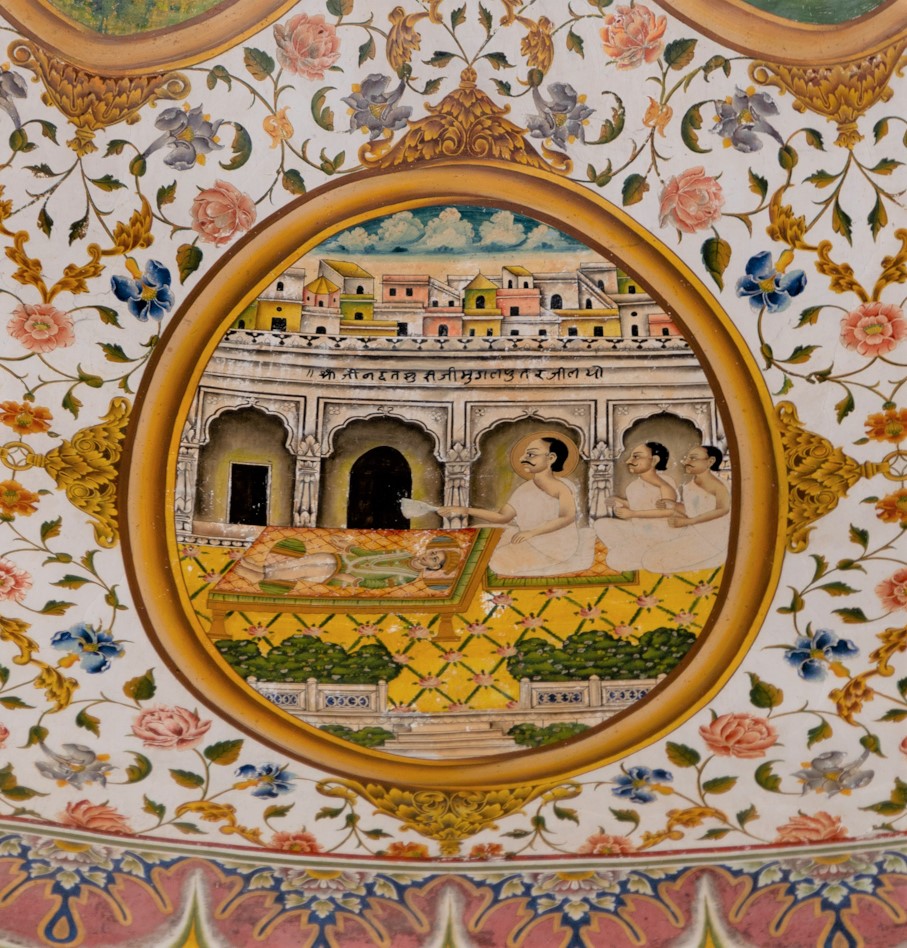
The story in the sixteenth oval painting (in clockwise order) in the lower/outer circle in the ceiling of the mandapa (pillared hall) revolves around Jinadatta Suri, probably depicting how he saved a drowning ship. The acharya (those who impart knowledge) is sitting on the banks of the water body, accompanied by three disciples. The ship in the water has an elephant head, and a person in Rajasthani attire is seated on the ship. The water contains aquatic flora and fauna, such as fish and lotus flowers. The inscription reads, ‘Shri Jinadatta Suri ji ne nevai dari.’ The most interesting aspect of this painting is the name of the artist, M. Altaf, inscribed at the bottom of the oval border of the painting.

As per the inscription on the fifteenth oval painting (in clockwise order) in the lower/outer circle in the ceiling of the mandapa (pillared hall), it depicts Jinadatta Suri reviving a Mughal prince. The story, commonly told in Jain traditions, recounts that once a Mughal prince fell from a horse and died. Jinadatta Suri commanded Vyantar Dev (forest celestial beings) to enter the dead prince’s body and bring him back to life. The Mughal prince is shown sleeping on a charpahi (four-legged bed) in the courtyard of the haveli (mansion). In the background, several buildings are depicted, suggesting a city settlement. Some of these buildings exhibit European architectural designs. The inscription reads, ‘Shri Jinadatta Suri Ji mugal putar ji la yo.’

This painting in the inner/upper circle in the ceiling of the mandapa (pillared hall) depicts the 23rd Jain Tirthankara, Parshvanatha, standing on a multi-headed naga (serpant), with the hood crown positioned above the head of the lord. A naga couple in anthropomorphic form stands flanking the Tirthankara and bows down to him. Parshvanatha wears a crown and is adorned with jewellery. There are two gandharvas (celestial beings) in the sky above him. The inscription reads, ‘Parasnath Shvami.’

The painting in the inner/upper circle in the ceiling of the mandapa (pillared hall) likely depicts the story of Chandakaushika Nag and Mahavira. According to the tale, as Mahavira travelled through a forest, a snake named Chandak blocked his path. However, Mahavira, instead of being scared of him, stood at the place firmly. Chandak bit the Tirthankara, yet the latter remained calm, intending no harm to the snake. This story intends to teach everyone the importance of controlling anger and cultivating compassion. Mahavira has a divine halo behind his head, painted in golden colour. A temple dedicated to the snake is shown at the background of the painting. The inscription from this painting is not entirely legible, but it certainly includes the name of Mahavira Swami.
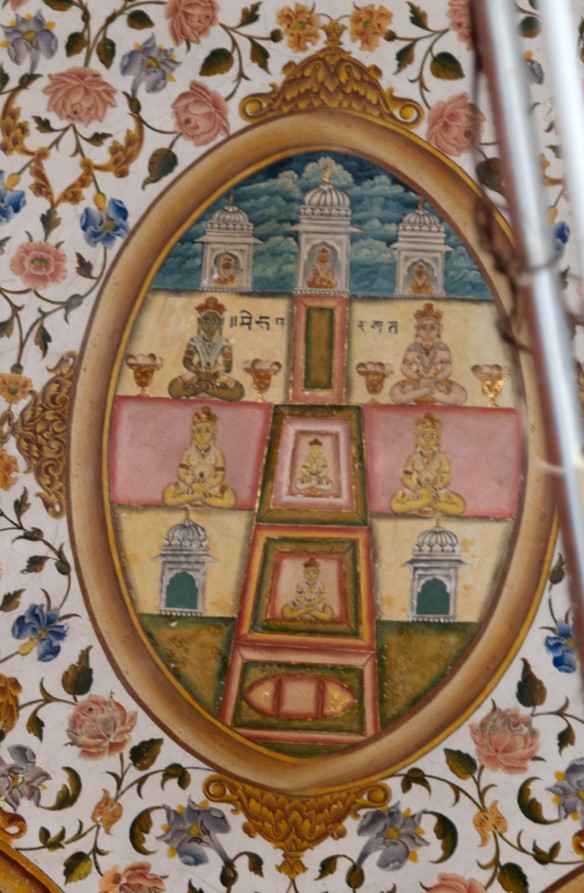
The painting in the inner/upper circle in the ceiling of the mandapa (pillared hall) has Mount Meru, the sacred mountain, depicted in the cosmic universe. There are five stages, from bottom to top, that symbolizes the centre of the world, which is surrounded by Jambudvipa, the earthly world. After every Tirthankara is born, he meets with god by ascending all these stages. Mount Meru painting illustrated the journey of the Tirthankara; hence, the centre of every stage has a Tirthankara sitting in a padmasana (lotus pedestal) pose. The inscription reads, ‘Meru Parbat.’

The story of the painting in the inner/upper circle in the ceiling of the mandapa (pillared hall) revolves around Mahavir Swami's stringent fasting conditions, which required specific circumstances for accepting food. Chandanbala, formerly known as Princess Vasumati, fulfilled these conditions despite enduring hardships as a slave after being separated from her royal family. The haveli (mansion), in which the princess is depicted sitting, reflects significant European architectural influence. Mistreated by a merchant’s wife, Chandanbala’s compassionate nature led her to offer lentils to Mahavir Swami, breaking his prolonged fast. This act of devotion resulted in her liberation from chains and being adorned with celestial riches. Recognized as Princess Vasumati, she was warmly received back into royalty by King Shaitanik and Queen Mrugavati, eventually receiving spiritual initiation from Mahavira Swami. The inscription reads, ‘Chandanbal Mahavir Shwami.'

The painting in the inner/upper circle in the ceiling of the mandapa (pillared hall) represents Chaude Rajlok, a concept in Jain traditions and cosmology that signifies four celestial realms or heavenly abodes. These realms are regarded as higher spiritual dimensions in Jainism, representing stages of spiritual evolution and attainment of purity, leading to liberation from the cycle of birth and death. The painting has a pyramid with a Tirthankara positioned at its apex. The inscription reads, ‘Chaude Rajlok.’
[1] Goetz, The Art and Architecture of Bikaner State, 60–61.
[3] Babb, ‘Monks and Miracles,’ 13.
[4] ‘Dada Shri Jina dutt Suri’.
[5] Babb, Absent Lord, 117–19.
[6] ‘Dada Shri Jinachandra Suri’.
[7] Jain, ‘Interaction of the “Lords,”’ 47–49.
[8] Gopal, Jains in India, 32–33.
Babb, L. A. ‘Monks and Miracles: Religious Symbols and Images of Origin among Osval Jains’. The Journal of Asian Studies 52, no. 1 (1993): 3–21. https://doi.org/10.2307/2059142.
Babb, Lawrence. Absent Lord: Ascetics and Kings in a Jain Ritual Culture. Vol. 8 of Comparative Studies in Religion and Society. California: University of California Press, 1996.
Dada Guru: Dedicated to Jain Dada Gurudev. ‘Dada Shri Jina dutt Suri’. https://dadaguru.in/. Accessed March 15, 2024.
Dada Guru: Dedicated to Jain Dada Gurudev. ‘Dada Shri Jinachandra Suri’. https://dadaguru.in/. Accessed March 15, 2024.
Goetz, H. The Art and Architecture of Bikaner State. Government of Bikaner State and the Royal India and Pakistan Society, 1950.
Gopal, Surendra. Jains in India: Historical Essays. 1st ed. London: Routledge, 2019.
Jain, Shalin. ‘Interaction of the ‘Lords’: The Jain Community and the Mughal Royalty under Akbar.’ Social Scientist 40, no. 3/4 (2012): 33–57.






















